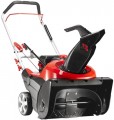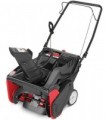Working width
The width of the strip of snow that the snow blower can clear in one pass. The larger the capture width, the fewer passes will be required to process the site, which is especially important on large areas. On the other hand, for processing small spaces, clearing individual paths, etc. significant width is not required (moreover, a “narrow” snow blower will pass more easily in a hard-to-reach place). The larger the capture width, the more powerful the engine, usually, ceteris paribus.
The most compact modern snow blowers have a working width of
less than 50 cm, these are mainly electric models of low power, although gasoline units are also found. A width of
50 – 60 cm can be called relatively small,
60 – 70 cm — medium, and in the largest models this figure
exceeds 70 cm.
Snow height
The maximum thickness of the snow layer that the snow blower removes in one pass. If you plan to regularly remove snow as it falls in a small area (for example, in the courtyard of your own private house), a grip height of up to 20 cm will be enough. If the opportunity to remove snow is rare (for example, in a country house where you visit only on weekends), you should pay attention to more powerful models with a height of about 50 cm.
Min. throw distance
The shortest distance that the snow blower can throw the collected snow.
The minimum range is indicated only for models with adjustable throw distance (see above). The meaning of this parameter is that in fact, long-range snow casting is not always desirable. For example, when clearing a path in the yard of a private house, snow often has to be poured literally next to the path, a little further — and it will fly onto the windows and walls of the house.
Note that the ejection range is a rather conditional value, because. snow (especially loose, freshly fallen snow) tends to dissipate in flight.
Max. throw distance
The maximum distance to which the snow blower can throw the collected snow (for models without throwing distance adjustment, the operating range itself). This value is rather arbitrary, since snow can be strongly dispersed in flight. Nevertheless, it characterizes the capabilities of the unit well and allows you to compare it with other models.
Long range is important mainly when working on large areas — it allows you to throw snow across the cultivated area so that it does not have to be collected a second time. As for specific figures, the value
up to 10 m is considered relatively small,
11 – 15 m — average, and in the most "long-range" models this figure can be
16 m or more.
Motor type
Model of the engine installed in the snow blower.
With this information, you can find detailed data on the engine — from official specifications to reviews, reviews and advice on specific nuances. In this way, you can evaluate how a snow blower with this particular engine will suit your needs.
Engine size
The size of the engine installed in a gasoline or diesel (see "Engine type") snow blower. With the same type of internal combustion engine (see above), more displacement usually means more power and more fuel consumption.
Motor power
Snowblower motor power in horsepower.
The universal unit of power today is watts, but for petrol and diesel engines (see "Motor type"), the traditional designation in horsepower may also be given. 1 HP approximately equal to 735 watts.
The higher the motor power, the higher the performance of the snow blower, the better it handles with high dense snowdrifts and icy crust. However, more powerful engines consume more fuel, weigh more and cost more, and their use is not always justified. Detailed recommendations on choosing the optimal power for a specific situation can be found in special sources.
Motor power
Snowblower motor power in watts. This designation is used for all electric models; for units with an internal combustion engine (see "Motor type"), the designation in horsepower may also be given (see above).
The higher the motor power, the higher the snowblower's flow rate, the better it copes with high dense snowdrifts and icy crust. However, more powerful engines consume more fuel, weigh more and cost more, and their use is not always justified. Detailed recommendations on choosing the optimal power for a specific situation can be found in special sources.
Starter
The method of starting motor (see "Motor type") of petrol snow blower. Today, the following options are available:
— Manual (starter rope). The simplest way to start: the operator pulls the cable, which turns the shaft and gives the engine the necessary initial impulse. Such starting systems are the most compact, simple and inexpensive, and they do not depend on power sources. On the other hand, it makes sense to use cables mainly in light and low-power snow blowers - to start heavy units, significant force is required, which is easier to provide with an electric starter.
—
Electric starter (230 V mains). Starting with an electric starter powered by a 230 V network (a regular socket). An electric starter is a small electric motor that turns the engine shaft when starting, giving it an initial impulse. Such systems are more complex, heavier and more expensive than cables, but are suitable even for the heaviest and most powerful engines; and the start itself is extremely simple - the user only needs to press a button. At the same time, power from the network allows you to do without heavy and expensive batteries. True, the network itself is required for starting, but this usually does not cause any special problems; and in case the snow blower stalls "in an open field", a backup starting system is usually provided in the form of the same cable. Therefore, most units with electric starters use power from the network.
...
— Electric starter (battery). Starting with an electric starter powered by a battery installed in the snow blower. For general features of electric starters, see above, and battery power makes the starting system as autonomous as possible: the starter can be used regardless of the presence of sockets nearby, and the battery is recharged from the running engine if necessary. On the other hand, the presence of a battery affects the cost and weight of the unit, and the mentioned autonomy is required relatively infrequently. Therefore, electric starters on batteries are used only in certain models of high-performance snow blowers designed for long-term operation "in the field", away from power grids; the weight and price of the battery in such cases are insignificant compared to the weight and price of the unit itself.
